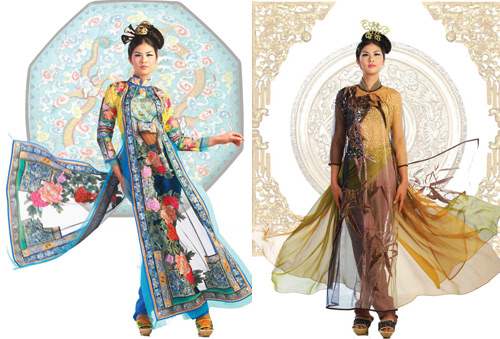Vietnam handicrafts in Haute Couture
In recent years, luxury fashion has transcended its conventional boundaries, delving deeper into the realm of cultural heritage. A significant trend emerging from this evolution is the integration of traditional Vietnamese handicrafts into high-end fashion collections. This fusion of artistry and couture not only enhances the fashion landscape but also plays a crucial role in preserving and celebrating Vietnam’s rich cultural heritage. By merging centuries-old techniques with contemporary design, luxury brands are crafting unique and profound fashion pieces that resonate with a global audience. Traditional Vietnamese handicrafts, imbued with cultural significance, are becoming pivotal in redefining the global fashion industry, offering a fresh perspective on luxury and sustainability.
The fusion of tradition and luxury
Traditional Vietnamese crafts have a deep-rooted history, with techniques passed down through generations. Crafts like silk weaving, brocade, and ramie weaving are not just products—they are cultural treasures that have been integral to Vietnamese life for centuries. These crafts hold spiritual significance and are often tied to cultural rituals and local myths, symbolizing the spirit and resilience of the Vietnamese people. For instance, Ha Dong silk weaving dates back to ancient times and is renowned for its fine quality and craftsmanship. Similarly, brocade weaving by ethnic minority groups reflects not only artistic talent but also the spiritual and cultural beliefs of these communities. These handicrafts are more than just beautiful items—they are cultural expressions that embody Vietnam’s heritage.

Vietnamese fashion has always been influenced by its traditional crafts. From the early integration of silk and brocade into Vietnamese clothing to the more modern incorporation of these elements into high fashion, the evolution of fashion in Vietnam is a story of blending tradition with innovation. Designers like Phan Dang Hoang and Minh Hanh have led this movement by incorporating traditional materials and techniques into their collections. Their work showcases the beauty of Vietnamese craftsmanship while adapting it for contemporary fashion. Phan Dang Hoang’s “Quintessence” collection, for example, uses silk yarn, handmade rattan, and bamboo, highlighting traditional craftsmanship while promoting Vietnamese culture on international platforms.
Modern application of traditional crafts
The materials used in traditional Vietnamese handicrafts—such as silk, brocade, and ramie—are highly prized for their unique textures, durability, and cultural significance. These materials are increasingly being incorporated into luxury fashion collections, where their inherent elegance and timeless appeal resonate with consumers. The challenge lies in blending these traditional crafts with modern fashion in a way that maintains their authenticity while embracing contemporary design trends.
Fashion designers are continually experimenting with innovative ways to integrate traditional aesthetics into modern fashion. This includes using cutting-edge design elements that respect the authenticity of traditional crafts while adapting them to current fashion trends. For instance, the application of traditional silk weaving techniques in contemporary fashion pieces not only preserves these ancient skills but also showcases them in a way that appeals to modern consumers.

The incorporation of Vietnamese handicrafts into luxury fashion has enriched the industry by introducing a new aesthetic rooted in tradition yet forward-looking. This fusion of tradition and luxury has renewed appreciation for Vietnamese artistry, now receiving recognition on the global fashion stage. Moreover, this trend benefits Vietnamese artisans by providing new opportunities for them to showcase their work and sustain their livelihoods. The global fashion industry’s growing interest in traditional crafts has opened doors for Vietnamese artisans to gain international acclaim and secure their place in the global market.
A look into some Vietnamese designers’ work
Phan Dang Hoang
Phan Dang Hoang’s designs are a testament to the richness of Vietnamese traditional craftsmanship. Using materials such as silk yarn and handmade bamboo, his “Quintessence” collection exemplifies the beauty and intricacy of these traditional crafts. This collection has not only been celebrated for its aesthetic appeal but also for its role in promoting Vietnamese culture on the international stage. The collection received acclaim at prominent international platforms, including the Nuova Accademia di Belle Arti (NABA) in Milan, highlighting the global appeal of Vietnamese craftsmanship.

Minh Hanh
Minh Hanh is another prominent designer who has adeptly integrated traditional Vietnamese materials, such as brocade and ramie, into high fashion. Her collections are renowned for their distinctive textures and aesthetics, which have made a significant impact on global fashion trends. Hanh’s work has garnered recognition from international fashion critics, further elevating the profile of Vietnamese handicrafts worldwide. Her designs exemplify how traditional materials can be transformed into contemporary fashion statements, bridging the gap between heritage and modernity.

What lies ahead?
One of the biggest challenges in integrating traditional crafts into luxury fashion is maintaining authenticity while adapting to modern demands. Balancing the preservation of ancient techniques with innovation is crucial for ensuring that traditional crafts remain relevant. Brands must develop strategies to honor these crafts while embracing contemporary design trends. As sustainability becomes a key focus in the fashion industry, traditional Vietnamese crafts offer eco-friendly alternatives to mass-produced materials. Many of these crafts use natural, sustainable materials and support fair trade practices, aligning with the growing demand for ethical fashion. Brands that successfully incorporate these elements into their collections are not only promoting sustainability but also supporting artisanal communities.
In conclusion, the integration of traditional Vietnamese handicrafts into luxury fashion is more than a trend—it’s a meaningful fusion that honors heritage while innovating for the future. As fashion moves towards sustainability and cultural relevance, this blend of tradition and luxury offers a blueprint for the future. By embracing traditional crafts, luxury brands are not only creating unique and authentic pieces but also preserving the rich cultural heritage of Vietnam for future generations.
______________________________________________________
Discover More on Instagram!
At AGD, we provide you with a gateway to the finest experiences in Vietnam. Stay connected with the latest trends and insights from Vietnam’s experience industry. Follow us on Instagram agdexperience for exclusive behind-the-scenes content, vendor highlights, and more extraordinary events coming your way.





